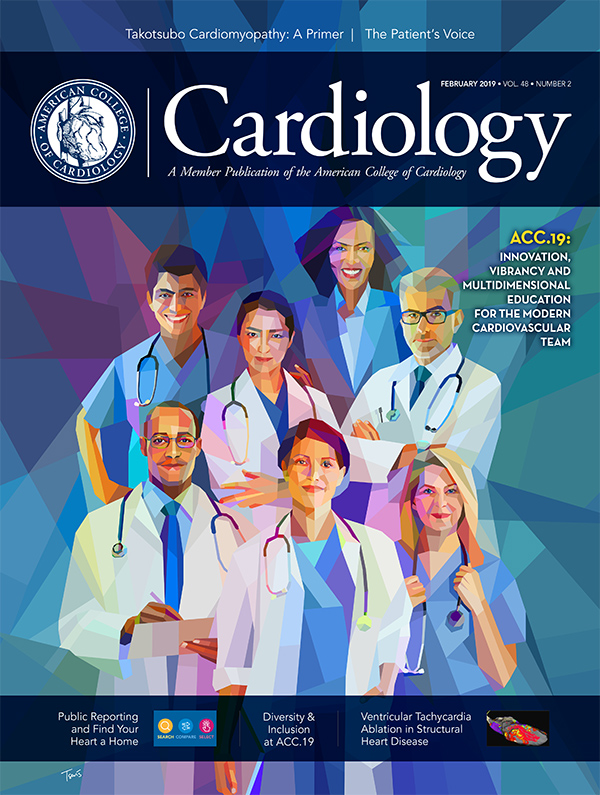From the Starting Line | American Heart Month and the Broken Heart Syndrome
"Doctor, I'm scared – what is happening to me? When I get upset, I develop chest pain."
She was a 41-year-old woman with nicotine dependence and hypertension admitted for chest pain evaluation and an elevated troponin. On the day of her hospital admission, she had an argument with a colleague at her workplace. During the argument, she suddenly developed severe substernal chest pain radiating into her neck and shoulders.
She was rushed to the emergency department. Her vitals showed elevated blood pressure of 161/112 mm Hg, heart rate of 85 bpm. Her labs were significant for elevated serial troponins with a peak troponin I of 2.72 ng/ml. Electrocardiogram (ECG) showed sinus rhythm with nonspecific ST-T abnormalities, QTc 444 ms. A cardiology consult was placed.
Takotsubo cardiomyopathy is also known as stress-induced cardiomyopathy or broken heart syndrome. It is a syndrome characterized by transient left ventricular (LV) dysfunction and a variety of wall-motion abnormalities that usually extend beyond a single coronary vascular bed.1
Compared with the general population, elderly postmenopausal women are most affected by Takotsubo cardiomyopathy. Excess catecholamine or sympathetic stimulation plays a central role in the pathophysiology of this cardiomyopathy. However, the precise mechanism by which catecholamine excess leads to the myocardial stunning seen in Takotsubo cardiomyopathy is unknown.
Takotsubo cardiomyopathy can be triggered by physical or emotional stressors – and it can occur spontaneously without an identifiable trigger. Interestingly, physical stressors occur more frequently than emotional stressors.2
Physical triggers occur more often in men, while emotional triggers occur more frequently in women. Physical stressors include subarachnoid hemorrhage, sepsis, physical activities or surgery. Emotional stressors include grief, relationship conflicts, anger or a positive event including a wedding or birthday party.3
The most common presenting symptom is chest pain, followed by shortness of breath. Abnormal laboratory findings include elevated troponin and brain natriuretic peptide. The ECG can show various abnormalities including ST elevation, T-wave inversions, nonspecific ST-T abnormalities and QTc prolongation.4,5 Regional wall motion abnormality is usually seen on cardiac imaging.
Different diagnostic criteria for Takotsubo cardiomyopathy have been proposed. The 2008 revised Mayo Clinic Diagnostic Criteria6 with four diagnostic criteria have been used extensively. With emerging knowledge on the pathophysiology of stress-induced cardiomyopathy, the International Takotsubo (InterTAK) Diagnostic Criteria was published in 2018.3
The InterTAK diagnostic criteria are:
- Transient LV dysfunction (hypokinesia, akinesia or dyskinesia) which can present as apical ballooning, midventricular, basal or focal wall motion abnormalities, and usually extends beyond a single epicardial vascular territory. Right ventricular involvement can be present.
- Emotional, physical or combined trigger (not obligatory).
- Neurologic disorders or pheochromocytoma may be a trigger.
- New ECG abnormalities are present (rare cases without ECG changes can occur).
- Elevation of cardiac biomarkers and brain natriuretic peptide is common.
- Significant coronary artery disease does not preclude the diagnosis.
- Infectious myocarditis is not present.
- Postmenopausal women are predominantly affected.
Using the regional wall motion abnormalities, four major types of Takotsubo cardiomyopathy have been described: apical ballooning (typical Takotsubo), midventricular, basal and focal wall motion.
An InterTak Diagnostic Score, developed by the International Takotsubo Registry, incorporates both clinical features (female sex, physical trigger, emotional trigger, psychiatric disorders, neurologic disorders) and ECG findings (absence of ST depression except in lead aVR and QT prolongation).7
Diagnosis of Takotsubo cardiomyopathy should be confirmed with LV imaging and coronary artery imaging, which can performed with invasive or noninvasive coronary angiography.
Management is predominantly supportive and adapted to the patient's clinical presentation and hemodynamics. A definitive treatment strategy specific for stress-induced cardiomyopathy has not been clearly defined. Resolution of the triggering physical or emotional stressors is important.
When acute complications such as heart failure and shock occur, these should be managed appropriately. The 2014 ACC/American Heart Association guideline recommends treatment with guideline-directed medical therapy where appropriate for patients with Takotsubo cardiomyopathy.8
When an intraventricular thrombus is detected, anticoagulation is recommended if there are no contraindications.7,8 Data from the International Takotsubo Registry suggests that the use of either angiotensin converting enzyme inhibitor or angiotensin receptor blocker improves one-year survival.2
That data also suggests there is no survival benefit with the use of beta-blockade, and that beta-blockers may not be effective in preventing Takotsubo cardiomyopathy. When cardiogenic shock occurs, it is important to evaluate for the presence or absence of LV outflow tract obstruction as this impacts therapy.8
My patient was right. Her emotional symptoms were the trigger for her clinical presentation. I discussed the role of coronary angiography with left ventriculogram for evaluating her coronaries and confirming our suspicion for Takotsubo cardiomyopathy.
Informed consent was obtained for left heart catheterization. Coronary angiography confirmed the absence of obstructive coronary artery disease and coronary artery vasospasm. Left ventriculogram showed dyskinesis of the inferior LV wall.
She was counselled on the importance of avoiding emotional stress. Echocardiogram prior to discharge showed resolution of her regional wall motion abnormalities. Her discharge medications included aspirin and lisinopril. At her post-hospitalization follow-up, she informed me that she had adopted stress-alleviating techniques into her daily routine at work and she had not experienced any episodes of chest pain.
As we celebrate American Heart Month and show affection to our loved ones on Valentine's Day, remember that stress contributes to cardiovascular disease including hypertension and the broken heart syndrome.
As cardiovascular health care providers, let's take time to reduce stress in our personal lives, strive for work-life balance, alleviate stress in the lives of our loved ones, and diligently watch for Takotsubo cardiomyopathy in our patients.

Nkechi Ijioma, MD, FACC, is an interventional cardiologist at Altru Health System in Grand Forks,ND, and clinical assistant professor at the University of North Dakota. She thanks Guy Reeder, MD, FACC, Abhiram Prasad, MD, FACC, and Philip Binkley, MD, FACC, for their expert review.
References
- Hurst RT, Prasad A, Askew JW 3rd, et al. JACC Cardiovasc Imaging 2010;3:641-9.
- Templin C, Ghadri JR, Diekmann J, et al. N Engl J Med 2015;373:929-38.
- Ghadri JR, Wittstein IS, Prasad A, et al. Eur Heart J 2018;7;39:2032-46.
- Frangieh AH, Obeid S, Ghadri JR, et al. J Am Heart Assoc 2016;5(6):e003418.
- Dib C, Asirvatham S, Elesber A, et al. Am Heart J 2009;157:933-8.
- Prasad A, Lerman A, Rihal CS. Am Heart J 2008;155:408-17.
- Ghadri JR, Wittstein IS, Prasad A, et al. Eur Heart J 2018;39:2047-62.
- Amsterdam EA, Wenger NK, Brindis RG, et al. J Am Coll Cardiol 2014;23;64:e139-e228.
Keywords: ACC Publications, Cardiology Magazine, Takotsubo Cardiomyopathy, Coronary Angiography, Lisinopril, Troponin I, Natriuretic Peptide, Brain, Aspirin, Coronary Vasospasm, Coronary Artery Disease, Shock, Cardiogenic, American Heart Association, Heart Rate, Myocardial Stunning, Pheochromocytoma, Hypokinesia, Subarachnoid Hemorrhage, Myocarditis, Workplace, Tobacco Use Disorder, Postmenopause, Blood Pressure, Depression, Follow-Up Studies, Work-Life Balance, Chest Pain, Echocardiography, Electrocardiography, Angiotensin-Converting Enzyme Inhibitors, Heart Failure, Cardiac Catheterization, Heart, Hypertension, Thrombosis, Hospitalization, Stress, Psychological, Emergency Service, Hospital, Emergency Service, Hospital, Anger, Sepsis, Catecholamines, Exercise, Registries, Informed Consent, Angiotensin Receptor Antagonists, Health Personnel, Dyspnea, Biomarkers, Pharmacological
< Back to Listings

